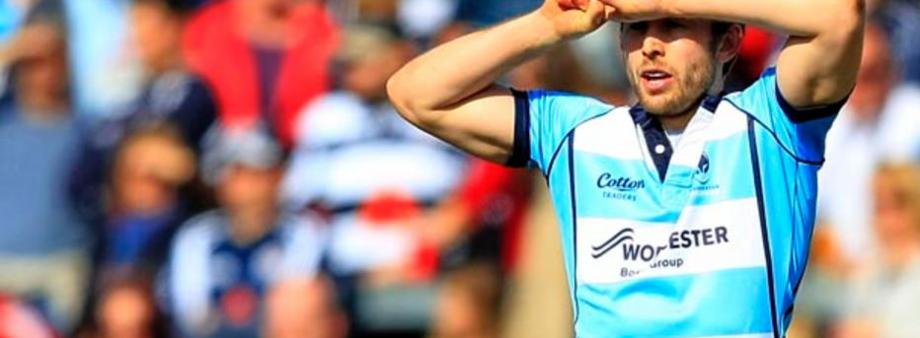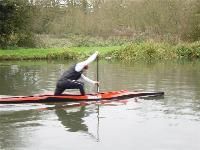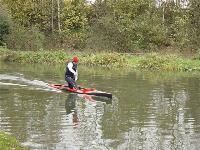
Marathon Canoeing
Canoeing wilderness expedition in Scotland, Deirdre Hansen, October 2010
To keep my daughter company and because it seemed fun I took up canoeing/kayaking in my mid forties. I have had Diabetes type 1 for 30 years. I thoroughly enjoyed myself on the water, gained some awards and became an assistant coach. For the recreational paddler, the sport is a seasonal sport with activity levels much higher from April to September. Water is too cold in the winter! You can go from 20 hours per week paddling in high season to 3 hours a month in mid-winter unless you are very serious about this or a bit mad!
I managed to keep my blood glucose levels at a reasonable level whilst on the water, but after a weekend on the water I would spend Sunday evening to Friday battling with many very high and low levels. I had generally sorted myself out by Friday only to start the balancing act again. This was a nuisance, caused my family major hassle and it made me realise that I was not able to progress my canoeing and kayaking skills. I desperately needed to do more, but just did not know how to manage my diabetes. A week’s expedition, just to get better at this sport was what I needed, but I felt that I could not put others at risk by my unstable condition. It was suggested that I needed to see Dr. Ian Gallen, as Diabetes and Sport was his speciality. After meeting Dr. Gallen I went onto using a waterproof pump. I played around with it and worked out that I needed to reduce my basal rate to 80% for paddling on flat water trying to bring it back to 100% ½ hour before we finish. Usually the time on the water is longer than I anticipate and when you wear a dry suit you can‘t reach the pump. The remote control does not work for this application.
I felt ready to go on a canoeing expedition. Getting fit enough was one thing and then I realised that 7 days of paddling would affect my insulin management. Luckily Dr. Alistair Lumb, who trains and works with Dr. Gallen was able to guide me clearly on what may happen, what to do and warned me about certain pitfalls.
I felt ready to go on a canoeing expedition. Getting fit enough was one thing and then I realised that 7 days of paddling would affect my insulin management. Luckily Dr. Alistair Lumb, who trains and works with Dr. Gallen was able to guide me clearly on what may happen, what to do and warned me about certain pitfalls.
I had the opportunity of going on a canoeing expedition paddling from the top of Loch Shiel, out to sea and paddling along the coast to Mallaig, wilderness camping on the way. I was aware that I would need to reduce my basal rate on a sliding scale and that it could go down to as low as 60%. I started by using the temporary basal rate, but quickly realised that I would need to reduce the basal rate permanently. At tea breaks we ate enormous pieces of flapjack, for which I needed to inject, as I had not realised the amounts of carbs they contained. All was going well and then gale force winds forced us to change plan.
Plan B was to move to the Spey and paddle to Spey Bay. Lots of paddling available, but also white water, I had no white water skills and was scared. I knew dealing with this would give me adrenalin surges which would mean a rethink of my insulin management. The odd time I had been on some moderate white water, I had always ended up with very high blood glucose levels. But paddling was more important!
I then reduced my basal rate by 10% in total, but changed the hourly rates by various amounts. The days had varied starts and finishes, so lot’s of juggling was required. As the week wore on I got more tired and the howling winds did not make for a good nights sleep. Late starts in the morning meant more insulin in the morning, progressively reducing the dose during the day with the over night dose cut dramatically. I over did it a bit and then had to increase it; I did not cut the early evening enough to start with. Otherwise I would have hypos between 9-12pm as well as overnight.
The intensity of the exercise was not as great as I had expected and we did not paddle for as long either each day. Capsizing gives enormous adrenalin surges and the energy required to get back in your boat, rescue kit etc is awesome. Dry clothes, an extra dose of insulin and a snack as soon as possible are vital. The camping required more energy than I had expected. Setting up camp each day and taking it down again in the morning as well as collecting firewood and general domestic chores kept us all busy. The adrenalin rush that you get from the conditions is frightening. I could go from 6.9 to 15.0 in less than ½ an hour even paddling like mad. At first I though my pump was not working correctly and tried replacing the canula and the transfer link.
I then reduced my basal rate by 10% in total, but changed the hourly rates by various amounts. The days had varied starts and finishes, so lot’s of juggling was required. As the week wore on I got more tired and the howling winds did not make for a good nights sleep. Late starts in the morning meant more insulin in the morning, progressively reducing the dose during the day with the over night dose cut dramatically. I over did it a bit and then had to increase it; I did not cut the early evening enough to start with. Otherwise I would have hypos between 9-12pm as well as overnight.
The intensity of the exercise was not as great as I had expected and we did not paddle for as long either each day. Capsizing gives enormous adrenalin surges and the energy required to get back in your boat, rescue kit etc is awesome. Dry clothes, an extra dose of insulin and a snack as soon as possible are vital. The camping required more energy than I had expected. Setting up camp each day and taking it down again in the morning as well as collecting firewood and general domestic chores kept us all busy. The adrenalin rush that you get from the conditions is frightening. I could go from 6.9 to 15.0 in less than ½ an hour even paddling like mad. At first I though my pump was not working correctly and tried replacing the canula and the transfer link.
My range of blood glucose levels for the week were 2.8-17.2 mmol/l, not brilliant, but not bad either. I had one, 20.3 mmol/l but this was due to my canula becoming dislodged. A hazard of the type of sport and the water conditions. Most days I only had one mild hypo a day and let my blood glucose levels run at a higher level than normal. I could mange myself the whole time.
I did need to top up with cereal bars/gels during the day, as stops for lunch, snacks and dinner are not predictable on the water. My buoyancy aid pocket always had a supply of emergency food. Generally with paddling for several hours at average intensity you have to load up with carbs early on in the day and ease off near the end. Protein required in the evening. It is not easy trying to eat something on moving water and with hindsight a camelback in a back pocket of a buoyancy aid would have been a better option, but it had not occurred to me. After several days on the water you don’t seem to need as much carbs as at the beginning, unless you have to deal with long stretches of harsh conditions water, when you need extra carbs just as fuel.
I did need to top up with cereal bars/gels during the day, as stops for lunch, snacks and dinner are not predictable on the water. My buoyancy aid pocket always had a supply of emergency food. Generally with paddling for several hours at average intensity you have to load up with carbs early on in the day and ease off near the end. Protein required in the evening. It is not easy trying to eat something on moving water and with hindsight a camelback in a back pocket of a buoyancy aid would have been a better option, but it had not occurred to me. After several days on the water you don’t seem to need as much carbs as at the beginning, unless you have to deal with long stretches of harsh conditions water, when you need extra carbs just as fuel.
It was an awesome trip, which I could not have done without the pump and the guidance from Dr Lumb. I can’t wait to do the next one, Sweden maybe?
On my return I have found that managing to balance my insulin requirements for the drop in exercise was a new battle I had not contemplated. Going from outdoor living and 5-6 hours of physical exercise a day back to a bit of swimming, cycling and an office job has thrown up many highs and some nasty lows. I had not thought about this and did not raise my insulin levels back to normal quickly enough. It took a few weeks to balance myself again. Now when I exercise at a moderate level I need to reduce my insulin levels. Before the trip I only needed to do it for exercise of more than 45 minutes. Now even ½ hour swim, not wearing my pump will drop my BG’s from 7 to 2. I have to make sure I take in additional carbohydrates even for short activity, which I did not have to do before.
My skills have improved tremendously and I had a great time, except the rain and wind!
I feel confident that I can now manage my diabetes in extreme conditions. The pump does require you to take lots of extra bits along with you, many spares; you have to look at a worst case scenario. Out at sea it might not have been that easy to get to a doctor or a hospital.
I feel confident that I can now manage my diabetes in extreme conditions. The pump does require you to take lots of extra bits along with you, many spares; you have to look at a worst case scenario. Out at sea it might not have been that easy to get to a doctor or a hospital.
Diabetes should not hold you back to try new things; new experiences are not just for young people, the very fit and very sporty people. You do have to plan; you have to try and get as much information as possible and be sensible, but overall you should do things that you enjoy and not let Diabetes hold you back. You should always ask. I have been lucky to have come across the most amazing medical people in the diabetes world who are very knowledgeable and generous in their offers of help and advice and have never discouraged me in doing new and different things. We can do things today that we would not even dream of 20 years ago. Just make the most of it and enjoy.
By John Badelek
I am a thirty year old who was diagnosed with Type 1 diabetes 22 years
ago. During this time I have never let diabetes rule my life and have never
let diabetes restrict my involvement with sport, be it cycling,
snowboarding or canoeing.
ago. During this time I have never let diabetes rule my life and have never
let diabetes restrict my involvement with sport, be it cycling,
snowboarding or canoeing.
Since the age of 16 I have been competing in both sprint and marathon
canoeing. Previously, I have found the demands on my body difficult to cope with whilst competing in sequential weekend races. These races involve
heats and finals in distances including 200m, 500m and 1000m in both
singles and doubles with little recovery between.
Due to this I predominantly focused on marathon canoeing and in the last year of being a junior (18 years old) I finished third in the Junior
Europeans, over 12 miles. As a senior I have competed at numerous World cup events in a double canoe, winning the National championships in 1988 and finishing 8th in the World Championships (26 miles) in 2001.
I currently work as a senior radiographer at the Royal Brompton Hospital
which also means working 24 hour shifts on site and periods of on call from
home, which can sometimes create difficulties in controlling my blood
sugars.
canoeing. Previously, I have found the demands on my body difficult to cope with whilst competing in sequential weekend races. These races involve
heats and finals in distances including 200m, 500m and 1000m in both
singles and doubles with little recovery between.
Due to this I predominantly focused on marathon canoeing and in the last year of being a junior (18 years old) I finished third in the Junior
Europeans, over 12 miles. As a senior I have competed at numerous World cup events in a double canoe, winning the National championships in 1988 and finishing 8th in the World Championships (26 miles) in 2001.
I currently work as a senior radiographer at the Royal Brompton Hospital
which also means working 24 hour shifts on site and periods of on call from
home, which can sometimes create difficulties in controlling my blood
sugars.
Depending on the time of year and pending races, my training consists of
14-20km paddles after work, usually taking anywhere between 1 to over 2
hours. Races are usually held on a Sunday and races can vary from 8 miles
for a local race, 15 miles for a national selection race and 26 miles for
full internationals. My current aim is to race internationally and compete
for top honours. I am currently taking Actrapid three times a day; vary my units depending on work/training schedules and Lantus in the evening. I monitor my blood sugars regularly.
14-20km paddles after work, usually taking anywhere between 1 to over 2
hours. Races are usually held on a Sunday and races can vary from 8 miles
for a local race, 15 miles for a national selection race and 26 miles for
full internationals. My current aim is to race internationally and compete
for top honours. I am currently taking Actrapid three times a day; vary my units depending on work/training schedules and Lantus in the evening. I monitor my blood sugars regularly.



